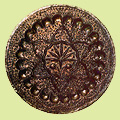Metal crafting in Bangladesh is an ancient tradition with the earliest object, a punch-marked coin, having been made in the first century BC at Wari-bateswar, Narsinghdi. Based on traditional knowledge and the inherent skills of the artisans the craft attained a high standard.
Artisans over the years have produced an amazing range of cast and worked objects in metal, from temple-icons made by the lost-wax process to ornamental studs, like the one Nawab Sirajuddoulah wore during darbar (now in the Victoria and Albert Museum, London). However, the most commonly crafted metal products were and continue to be vessels and utensils, in numerous shapes and sizes. These objects of daily use combine aesthetics with form and function to meet the everyday needs of their users.
Metals used in crafting have traditionally been copper, bronze (copper and tin alloy), brass (copper and zinc alloy), bell (tin and copper alloy) gold, silver, iron, panchaloha (literally, five metals, an alloy of copper, brass, lead, silver, gold) and ashtadhatu (alloy of silver, gold, copper, zinc, lead, tin, iron, mercury).
In Bangladesh most of the commonly used household products are made from brass, bell metal or copper – Cooking pots, pitchers, plates, tumblers and bowls are made in diverse shapes and sizes. A variety of other products like tableware, tabletop and wall hangings are often made out of sheet metal by alternatively hitting and hammering the metal. The raw material is usually obtained from various sources – through smelting minerals; by melting old scrap or through the purchase of sheet metal. Since they need daily cleansing and scouring, the utensils crafted are usually of simple, graceful forms with hammered or incised patterns rather than raised decorations. However, other utilitarian articles like betel nut cutters, rice measures, lamps, ceremonial stools and kulas (winnows) are very often beautifully decorated in punched or engraved patterns of linear and floral motifs and in dots displayed in a variety of arrangements.
The artisans employ a number of techniques to craft the metal – including among others shaping, casting- both solid and hollow, engraving, enamelling and repousse work.
BEATEN AND HAMMERED PRODUCTS
TECHNIQUE AND PROCESS
The beating process is often preferred for bell metal and cooper, particularly since it is believed to make the object more durable.
Scrap metal of copper and zinc along with brass scraps are put into a clay pot and melted over a coal fire dug in the ground and fanned with bellows to produce a molten liquid. This is poured into an iron plate and left to cool.
The metal is then hammered into sheets or bars. It is repeatedly subjected to further tempering for extra strength, by heating the article red hot, suddenly dipping it in cold water and then hammering it again.
The resultant metal is shaped by placing the hammered sheet on a bed of thick clay mixed with rice husk. The shaping of an object is done by beating with a hammer to the approximate shape.
Traditional food plates (thalis) are beaten into shape, and polished to a smooth surface in this manner.

WOVEN METAL
TECHNIQUE AND PROCESS
Brass sheets imported from China, Japan, and Korea are available locally. Narrow strips of these are cut in the required lengths, similar to the strips prepared by a bamboo craftsman for weaving a basket.
Using the principle of a floor mat, the strips are laid across each other and the artisan starts interweaving them.
When the woven size is approximately 8”x 8”, the artisan starts folding the strips upwards and interlacing the ends, into each other. Sometimes wires are used to secure the strips and maintain the shape but are removed later.
When the top edge (height) of the object is reached the ends are folded downwards, and extra metal cut off.
A belt or upper rim is woven separately. A thin strip of brass is wrapped over with another flat strip. This belt is placed on the upper or top end of the basket, and fitted over the rough folded edges and fastened. This is the final step of the woven basket.

ENGRAVED METAL
TECHNIQUE AND PROCESS
Engraving on metal products made from copper, brass and bell metal is used to decorate and ornament a range of products. In this process the surface decoration is incised or chased in outline on the objects against a frosted background that is either polished metal or a buffed enamel surface.
The artisan colours the surface of the metal with a liquid mixture of black dye which dries easily. The patterns are worked into the metal with a chisel and hammer by cutting lines over the surface. The engravings create a contrast on the black surface to the glinting metal below.
These free hand etchings depict religious symbols, images of national monuments, portraits of famous personalities, idyllic rural landscapes, floral and geometric designs.
REPOUSSE
Products of repousse work include wall plaques, decorative panels, medallions, plates, bowls, trays, rosewater sprinklers. In this process a flat piece of metal or a rounded part of a vessel is filled with lac and a basic pattern is drawn on to it. The design emerges as the metal is beaten with hammer strokes.
LOCATION
Copper, brass and bell metal objects are made in 23 craft clusters in Bangladesh including Palong (Faridpur), Dariabad, Islampur (Jamalpur), Charabari, Bamil (Tangail), Ramchandrapur (Comilla) Nama-Sankarbati (Chapai Nawabgong), Kalia, Shimulia, Dharai (Dhaka) and Uttaramabaria, Mirsarai (Chittagong). Bronze icons used to be made in Dhaka dakshin (Sylhet) and Canons in Rajnagar (Moulavibazar); but this is now a languishing craft.
Blacksmith clusters, 404 in number, produce a wide range of objects for everyday use; often combining aesthetics and utility in commonly used products that include Korani (coconut scraper) chhorota (betel nut cracker), hamandista (grinder).
Gallery
YOUR VIEWS
PRACTITIONERS: INDIA
Access 70,000+ practitioners in 2500+ crafts across India.
BIBLIOGRAPHY
10,000+ listings on arts, crafts, design, heritage, culture etc.
GLOSSARY
Rich and often unfamiliar vocabulary of crafts and textiles.
SHOP at India InCH
Needs to be written.





